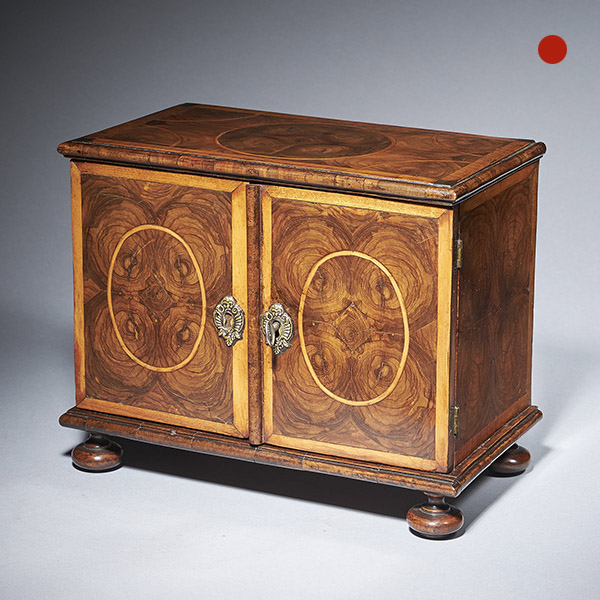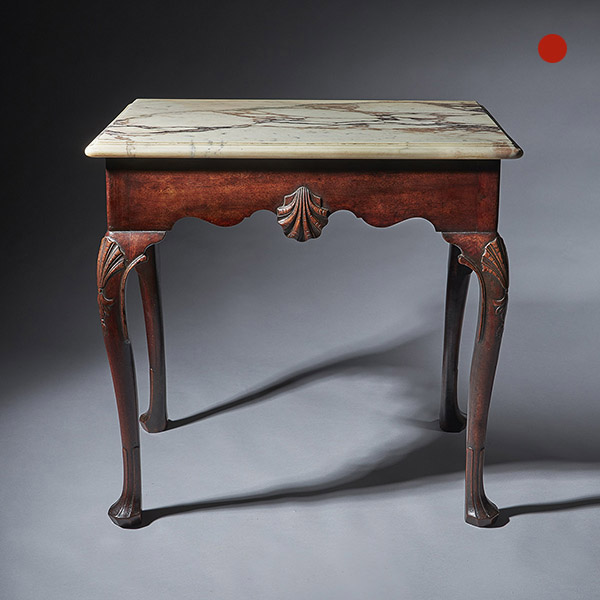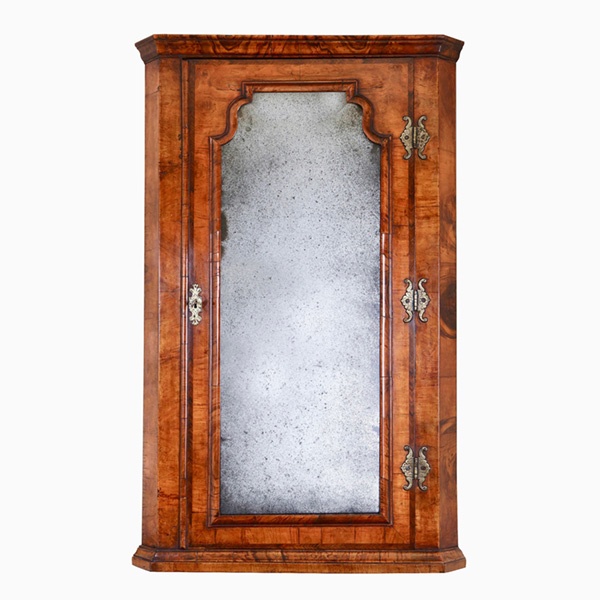Early 18th Century George I Highly Figured Walnut Double Dome Bookcase on Chest
Sold
Request Information
Follow Us
Early 18th Century George I Highly Figured Walnut Double Dome Bookcase on Chest
An exceptional and original highly figured George I walnut double dome bookcase on chest, circa 1720-1730. To the bookcase, original surmounted walnut finials on moulded chimneys sit above well-shaped moulded double dome arches to the front and sides.
The shaped break-arch doors with original hand-bevelled mercury mirror plates sit inside moulded and feather banded frames above candle slides, opening on shaped gilt-brass chased strap hinges to reveal the four-pin lock, shaped gilt brass clasps and four double-D moulded and grained shelves. Raised on two short over three long oak-lined graduating drawers, each double book-matched and framed to each side with fine feather-banding and cross banding.
This technique appears to have originated in the workshops running down the Southside of St Pauls Churchyard in the first quarter of the 18th century, which housed some of the most renowned cabinet makers of the time. It should be noted that pieces such as this are rare; rarer still, in original condition, with all original features, to include: chased brass furniture, feet, finials, shelves, mirror plates and possibly most crucially untouched patinated surfaces.
Condition
Good
In original condition, with all original features, to include chased brass furniture, feet, finials, shelves, mirror plates and possibly most crucially untouched patinated surfaces. Conserved. Wear consistent with age and use.
Dimensions
Width: 41.34 in. (105 cm)
Depth: 22.05 in. (56 cm)
PREVIOUSLY SOLD

Fine 18th Century Queen Anne Burr and Highly Figured Walnut Card Table
Fine 18th Century Queen Anne Burr and Highly Figured Walnut Card Table SoldFollow UsFine 18th Century Queen Anne Burr and Highly Figured Walnut Card Table A fine and rare Queen Anne burr and highly figured walnut card table, circa 1710...

18th Century George II Mahogany Miniature Bureau
18th Century George II Mahogany Miniature Bureau SOLD Follow Us18th Century George II Mahogany Miniature Bureau What came first.... the miniature or the full scale? This small scale model at just 9” wide dates from the very beginning of the...

17th Century Charles II Cocuswood Lace Box, Circa 1660, England
17th Century Charles II Cocuswood Lace Box, Circa 1660, England SoldFollow Us17th Century Charles II Cocuswood Lace Box, Circa 1660, England An extremely rare and important Cocuswood oyster (Brya ebenus) lace box from the reign of Charles II,...

A superb 17th-century olive oyster lace box from the reign of King Charles II, circa 1675-85.
A superb 17th century olive oyster lace box from the reign of King Charles II, circa 1675-85. Geometric patterns adorn the selected and book-matched hand cut olive oysters to the top which is beautifully inlaid with fine boxwood stringing, cross-banded and edged with cross grain mouldings, all in figured olive.

17th-Century miniature table cabinet
The miniature table cabinet opens to an arrangement of drawers, a row of four, a bank of four and a long pen drawer, similarly veneered in oysters of olive.

A Delightful Mid 18th Century Irish Mahogany Console Table of Small Proportions (29”) Circa 1750-1760.
A Rare Mid 18th-Century Irish Mahogany Console Table of Small Proportions (29”)
With Moulded Edged Calacatta Rosati Marble.

Fine 18th Century Queen Anne Burr and Highly Figured Walnut Card Table
Fine 18th Century Queen Anne Burr and Highly Figured Walnut Card Table SoldFollow UsFine 18th Century Queen Anne Burr and Highly Figured Walnut Card Table A fine and rare Queen Anne burr and highly figured walnut card table, circa 1710...

18th Century George II Mahogany Miniature Bureau
18th Century George II Mahogany Miniature Bureau SOLD Follow Us18th Century George II Mahogany Miniature Bureau What came first.... the miniature or the full scale? This small scale model at just 9” wide dates from the very beginning of the...

17th Century Charles II Cocuswood Lace Box, Circa 1660, England
17th Century Charles II Cocuswood Lace Box, Circa 1660, England SoldFollow Us17th Century Charles II Cocuswood Lace Box, Circa 1660, England An extremely rare and important Cocuswood oyster (Brya ebenus) lace box from the reign of Charles II,...

A superb 17th-century olive oyster lace box from the reign of King Charles II, circa 1675-85.
A superb 17th century olive oyster lace box from the reign of King Charles II, circa 1675-85. Geometric patterns adorn the selected and book-matched hand cut olive oysters to the top which is beautifully inlaid with fine boxwood stringing, cross-banded and edged with cross grain mouldings, all in figured olive.

17th-Century miniature table cabinet
The miniature table cabinet opens to an arrangement of drawers, a row of four, a bank of four and a long pen drawer, similarly veneered in oysters of olive.

A Delightful Mid 18th Century Irish Mahogany Console Table of Small Proportions (29”) Circa 1750-1760.
A Rare Mid 18th-Century Irish Mahogany Console Table of Small Proportions (29”)
With Moulded Edged Calacatta Rosati Marble.
YOU MAY ALSO LIKE

Queen Anne Walnut Corner Cupboard with Bevelled Mirror Plate
A truly remarkable find in original condition. To the door a shaped soft bevelled mirror plate is framed by a cross-grain molding of typical queen Anne design which is further cross-banded, feather-banded and edged to the opening with a single de-molding.

Queen Anne Walnut Corner Cupboard with Bevelled Mirror Plate
A truly remarkable find in original condition. To the door a shaped soft bevelled mirror plate is framed by a cross-grain molding of typical queen Anne design which is further cross-banded, feather-banded and edged to the opening with a single de-molding.













